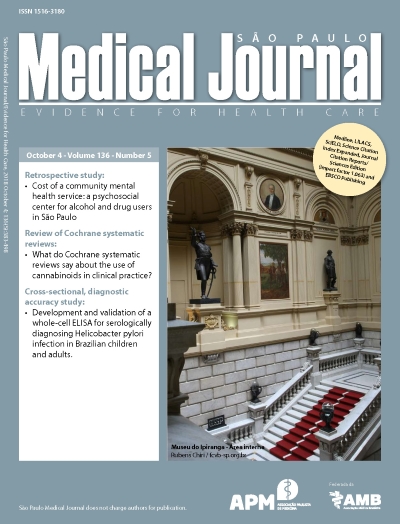Cross-sectional epidemiological investigations of Giardia lamblia in children in Pakistan
Palavras-chave:
Prevalence, Giardia lamblia, Risk factors, Child, PakistanResumo
BACKGROUND: The prevalence of Giardia lamblia in Pakistani children is currently unknown. The aim here was to evaluate the prevalence and risk factors of Giardia lamblia in children exhibiting diarrhea. DESIGN AND SETTING: Cross-sectional study at different district healthcare hospitals in Pakistan. METHODS: A total of 800 samples were collected from children aged 0-10 years. Information regarding personal data, demographic data and supposed risk factors was collected through a structured question- naire. Giardia lamblia was detected through direct microscopy and antigens through the enzyme-linked immunosorbent assay (ELISA). RESULTS: The prevalence of Giardia lamblia was 2.75% through direct microscopy and inflated to 9.5% through ELISA. The demographic factors positively associated with occurrences of giardiasis were age (P = 0.035; odds ratio, OR = 1.96; 95% confidence interval, CI = 1.094-3.533), mother’s educational level (P = 0.031; OR = 2.67; 95% CI = 1.186-6.045) and father’s educational level (P = 0.004; OR = 3.56; 95% CI = 1.612-7.899). Similarly, among the supposed risk factors, rural residency (P = 0.032; OR = 1.76; 95% CI = 1.098- 2.851), absence of proper sewerage system (P = 0.000; OR = 6.60; 95% CI = 4.029-10.841) and unavailability of safe drinking water (P = 0.000; OR = 4.08; 95% CI = 2.207-7.547) were the factors strongly connected with giardiasis. Abdominal discomfort was a prominent clinical sign with 46% frequency. CONCLUSION: Various risk factors were associated with occurrences of Giardia, thus emphasizing the importance of parents’ education, safe drinking water and proper sewerage systems for Pakistani chil- dren’s health.
Downloads
Referências
Ali SA, Hill DR. Giardia intestinalis. Curr Opin Infect Dis. 2003;16(5):453-60. PMID: 14501998; doi: 10.1097/01.qco.0000092817.64370.ab.
Adam, RD. Biology of Giardia lamblia. Clin Microbiol Rev. 2001;14(3): 447- 75. PMID: 11432808; doi: 10.1128/CMR.14.3.447-475.2001.
Thompson RC. Giardiasis as a re-emerging infectious disease and its zoonotic potential. Int J Parasitol. 2000;30(12-13):1259-67. PMID: 11113253; doi: 10.1016/S0020-7519(00)00127-2.
Thompson RC. The zoonotic significance and molecular epidemiology of Giardia and giardiasis. Vet Parasitol. 2004;126(1-2):15-35. PMID: 15567577; doi: 10.1016/j.vetpar.2004.09.008.
Lengerich EJ, Addiss DG, Juranek DD. Severe giardiasis in the United States. Clin Infect Dis. 1994;18(5):760-3. PMID: 8075266; doi: 10.1093/clinids/18.5.760.
Tariq MT. Prevalence of Giardiasis in Afghan population. Pak Pediatr
J. 2013;37(3):180-4. Available from: https://www.researchgate.net/publication/287318505_Prevalence_of_Giardiasis_in_Afghan_ Population. Accessed in 2018 (Aug 24).
Savioli L, Smith H, Thompson A. Giardia and Cryptosporidium join the ‘Neglected Diseases Initiative’. Trends Parasitol. 2016;22(5):203-8. PMID: 16545611; doi: 10.1016/j.pt.2006.02.015.
Mank TG, Zaat JO, Deelder AM, et al. Sensitivity of microscopy versus enzyme immunoassay in the laboratory diagnosis of giardiasis. Eur J Clin Microbiol Infect Dis. 1997;16(8):615-9. PMID: 9323478; doi: 10.1007/BF02447929.
Julio C, Vilares A, Oleastro M, et al. Prevalence and risk factors for Giardia duodenalis infection among children: a case study in Portugal. Parasit Vectors. 2012;5:22. PMID: 22284337; doi: 10.1186/1756-3305-5-22.
Oberhuber G, Kastner N, Stolte M. Giardiasis: a histologic analysis of 567 cases. Scand J Gastroenterol. 1997;32(1):48-51. PMID: 9018766; doi: 10.3109/00365529709025062.
Al-Mekhlafi MS, Azlin M, Nor Aini U, et al. Giardiasis as a predictor of childhood malnutrition in Orang Asli children in Malaysia. Trans R Soc Trop Med Hyg. 2005;99(9):686-91. PMID: 15992838; doi: 10.1016/j.trstmh.2005.02.006.
Abrar Ul Haq K, Gul NA, Hammad HM, et al. Prevalence of Giardia intestinalis and Hymenolepis nana in Afghan refugee population of Mianwali district, Pakistan. Afr Health Sci. 2015;15(2):394-400. PMID: 26124784; doi: 10.4314/ahs.v15i2.12.
Korzeniewski K, Konior M, Augustynowicz A, Lass A, Kowalska E. Detection of Giardia intestinalis infections in Polish soldiers deployed to Afghanistan. Int Marit Health. 2016;67(4):243-7. PMID: 28009386; doi: 10.5603/IMH.2016.0043.
Chaudhry ZH, Afzal M, Malik MA. Epidemiological factors affecting prevalence of intestinal parasites in children of Muzaffarabad district. Pakistan J Zool. 2004;36(4):267-71. Available from: https://zsp.com.pk/pdf36/PJZ-165-03.pdf. Accessed in 2018 (Aug 24).
Duffy T, Montenegro-Bethancourt G, Solomons NW, Belosevic M, Clandinin MT. Prevalence of giardiasis in children attending semi-urban day care centres in Guatemala and comparison of 3 Giardia detection tests. J Health Popul Nutr. 2013;31(2):290-3. PMID: 23930348; doi: 10.3329/jhpn.v31i2.16394.
Upcroft P. Meeting report: Anaerobic Protozoan Parasites, Prague, Czech Republic, July 15-19, 2001. Protist. 2001;152(4):241-2. PMID: 11822654; doi: 10.1078/1434-4610-00000.
Anim-Baidoo I, Narh CA, Oddei D, et al. Giardia lamblia infections in children in Ghana. Pan Afr Med J. 2016;24:217. PMID: 27800072; doi: 10.11604/pamj.2016.24.217.8012.
Kramar LV, Reznikov EV, Kramar OG. [Prevalence of giardiasis in Volgograd city population]. Med Parazitol (Mosk). 2003;(4):38-9. PMID: 14727490.
Wongstitwilairoong B, Srijan A, Serichantalergs O, et al. Intestinal parasitic infection among pre-school children in Sangkhlaburi, Thailand. Am J Trop Med Hyg. 2007;76(2):345-50. PMID: 17297047; doi: 10.4269/ajtmh.2007.76.345.
Abbas NF, El-Shaikh KA, Almohammady MS. Prevalence of Giardia lamblia in diarrheic children in Almadinah Almunawarh, KSA. J Taib Uni Sci. 2011;5:25-30. doi: 10.1016/S1658-3655(12)60035-1.
Suman MSH, Alam MM, Pun SB, et al. Prevalence of Giardia lamblia infection in children and calves in Bangladesh. Bangl J Vet Med. 2011;9(2):177-82. doi: 10.3329/bjvm.v9i2.13474.
Reinthaler FF, Feierl G, Stünzner D, Marth E. Diarrhea in returning Austrian tourists: epidemiology, etiology, and cost analyses. J Travel Med. 1998;5(2):65-72. PMID: 9772320; doi: 10.1111/j.1708-8305.1998.tb00466.x.
Choy SH, Al-Mekhlafi HM, Mahdy MA, et al. Prevalence and associated risk factors of Giardia infection among indigenous communities in rural Malaysia. Sci Rep. 2014;4:6909. PMID: 25366301; doi: 10.1038/srep06909.
Nematian J, Nematian E, Gholamrezanezhad A, Asgari AA. Prevalence of intestinal parasitic infections and their relation with socio-economic factors and hygienic habits in Tehran primary school students. Acta Trop. 2004;92(3):179-86. PMID: 15533285; doi: 10.1016/j. actatropica.2004.06.010.
Quihui L, Valencia ME, Crompton DW, et al. Role of the employment status and educational of mothers in the prevalence of intestinal parasitic infections in Mexican rural schoolchildren. BMC Public Health. 2006;6:225. PMID: 16956417; doi: 10.1186/1471-2458-6-225.
Bello J, Núñez FA, González OM, et al. Risk factors for Giardia infection among hospitalized children in Cuba. Ann Trop Med Parasitol. 2011;105(1):57-64. PMID: 21294949; doi: 10.1179/1364 85911X12899838413385.
Downloads
Publicado
Como Citar
Edição
Seção
Licença

Este trabalho está licenciado sob uma licença Creative Commons Attribution 4.0 International License.





